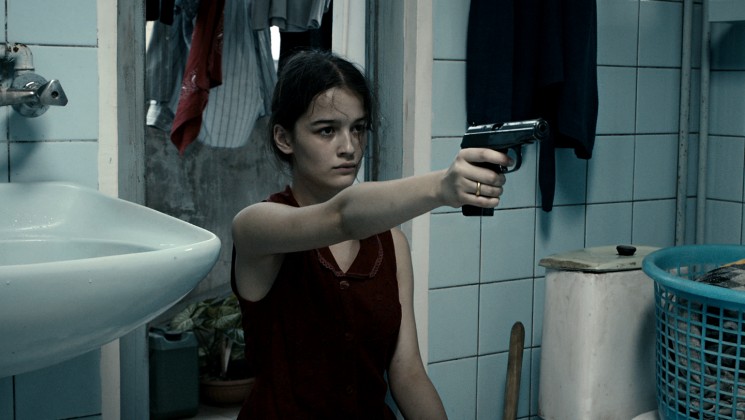
News
Pro-Palestine Encampment Represents First Major Test for Harvard President Alan Garber

News
Israeli PM Benjamin Netanyahu Condemns Antisemitism at U.S. Colleges Amid Encampment at Harvard

News
‘A Joke’: Nikole Hannah-Jones Says Harvard Should Spend More on Legacy of Slavery Initiative

News
Massachusetts ACLU Demands Harvard Reinstate PSC in Letter

News
LIVE UPDATES: Pro-Palestine Protesters Begin Encampment in Harvard Yard
Georgia "In Bloom"
"In Bloom"—Dir. Nana Ekvtimishvili and Simon Gross (Big World Pictures)—4 Stars

Coming-of-age films often feel worn-out and stereotypical. While the adolescent struggle to find purpose or make sense of the world is relatable, many films risk being unable to distinguish themselves from others in the genre, the result of being subjected to a predictable formula and overused themes. So when any production undertakes a such a project, the cast and crew must meet the challenge of finding a way to differentiate their work and tell a common story in a new manner—a challenge the Georgian drama “In Bloom” meets with masterly execution.
Eka Khizanishvili (Lika Babluani) and Natia Zaridze (Mariam Bokeria) are the adolescents of interest: 14-year-old best friends, the two live in Georgia during the early 1990s, a time of instability and violence after the Soviet Union’s collapse. Despite the intense backdrop, the two girls proceed through their lives normally, encountering bullies, strict teachers, family problems, and bittersweet love. This is not to say Georgia’s political and social affairs have no role in the story; in fact, their concealed yet threatening presence is what makes the film powerful and distinct.
Co-directors Nana Ekvtimishvili and Simon Gross weave a layered story by juxtaposing the girls’ daily lives with larger issues. Snippets from the radio and television are interspersed throughout the film and serve as reminders of Georgia’s precarious situation. This violence manifests itself most explicitly for Eka and Natia in the gun that Natia receives from her love, Lado (Data Zakareishvili); passed around between the girls, the gun fulfills an unseen newscaster’s urging at the beginning of the film. “There have always been people in Georgia who are warriors,” the newscaster says, and people must acquire guns to protect themselves. Yet instead of acting as a tool against the country’s strife, the gun becomes more of a defense against the violence in Natia’s and Eka’s own lives. And while this choice might detract from the significance of historical events, the film’s strength as a coming-of-age story derives from this artistic decision. While neutral on the events causing social strife and pain for the characters, the film embraces the fact that more tangible, noticeable problems are what have the greatest impact.
Babluani and Bokeria shine compared to other actors within the film, though they are not without faults. The two young actresses lack nuance in exhibiting their emotions, and the deficiency does cause many crucial scenes to feel static and one-dimensional. Babluani’s Eka feels reduced to being mostly forlorn and confused, and Bokeria oftentimes seems stuck in a state of anger or defiance. In some way, the simplicity of their expression allows them to create a clear contrast between the innocent teens running across fields and sharing secrets and the adults they have to be. Yet at moments, the two lack chemistry with each other; during a brief spat in the middle of the film, the fight feels cold, devoid of any disappointment or conflict, leaving any friendship prior feeling fake.
Cinematography contributes to the low-key feel of the film. The color scheme is soft: greys, browns, and blues shade most of the girls’ surroundings, and even when red or green hues are introduced, they are darkened and muted. Additionally, the film lacks a score—rather than using an orchestral piece, the film fills silences through the chirps of birds and shouts of the adults, a reminder of the personal conflicts occurring around the protagonists. When music does enter the film, it is in the context of the plot; a wedding scene is replete with a joyful melody and a gathering of girls is accompanied by Natia playing the piano. The result is a product that feels both grave and realistic.
Nevertheless, the film’s script does not free itself from traditional plot progression. The story follows a trend that, though different from films set in a less turbulent environment, is predictable. The climactic event that spurs Eka and Natia to reach their final growth might not be what the audience expects, but when it does arrive, it comes without shock. Some plot turns do feel surprising, such as parts of Natia’s love life, but this is a result of the film’s context. Set in a country dealing with social issues inconceivable in modern America, such as early marriages, the film provides moments when those cultural differences amaze.
That is not to discount the film’s achievement. Muted but potent, “In Bloom” breaks past the constraints of coming-of-age stories to create something much more complicated. Poignant and exploratory, the drama becomes a creative exploration of a nation through the lens of two girls.
—Contributing writer Ha D.H. Le can be reached at hadohuyle@college.harvard.edu.
Want to keep up with breaking news? Subscribe to our email newsletter.
